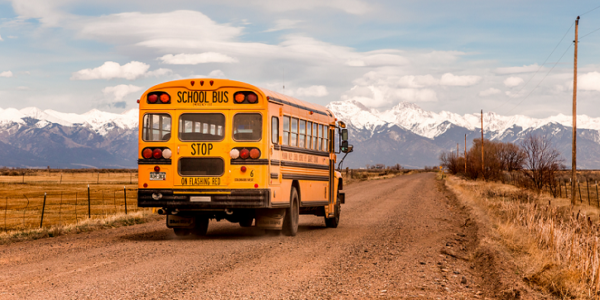Rural Challenges for Electric School Buses

Let’s talk about rural bus fleets, which comprise the bulk of EPA’s 7,000 plus prioritized school districts. The priority makes sense in that most rural areas have economic hardships. Their wages, property tax bases and therefore school district budgets are all smaller. Service, parts, emergency services and health services are all harder to access in rural areas due to longer distances. Rural fleets deserve the fuel and maintenance savings and health benefits that ESB’s bring. The Beneficial Electrification League gives great support to rural fleets, including with their new toolkit.

Gravel roads, which prioritized remote-rural and Tribal routes are famous for, eat up some battery energy, and therefore some range. Picture how you and I spend more energy riding a bicycle over gravel than over smooth asphalt. Not a deal killer, just something to note.
The irony is that, as a rural Transportation Director told me last year as he struggled with his first deployment, his ESB project takes time beyond his existing job description, time his district can’t pay him for. (The EPA has said that upcoming funding rounds may involve grants that fill this gap.) The ESB panelists at the Oregon Pupil Transportation Association (OPTA) conference I attended last month said, “You need a Project Manager to succeed at this.” One added that his good-sized staff and fleet of 300 can absorb the extra work, and the downtime in the shop his first-generation ESB’s have required, in a way a small fleet cannot (many rural fleets are small). He feels a duty to lead with new technology. I respect that.
While there are a number of successful deployments already in rural areas, let’s keep our expectations of rural fleets reasonable. I encourage all interested districts to apply for ESB funding, whether they are prioritized or not. It’s a lottery, and everybody has a shot at landing EPA’s Clean School Bus Program funding. Read on for another approach to making ESB’s affordable.
Our WASBE (Women Accelerating School Bus Electrification) dinner, cohosted by Forth and Lion, on June 28 in Portland, Oregon, during Forth’s Roadmap Conference. Upper left: Carolina Chacon of AESB and Jackie Piero of Nuvve. Upper right: WASBE cofounders me, Malinda Sandhu and Susan Mudd. Lower left: Caitlin Macomber and Stephanie Li of WRI. Lower right: Lilia Montoya Herra, the Transportation Director of Los Angeles Unified School District, and the only Latina Transportation Director in California.
The Repower Project (diesel to electric) I’m leading at Forth (see our Request For Proposals, due today) is proceeding. It took a verbal beating, though, when I informally talked it up at the ESB session of the OPTA conference. OK, the mechanics/technicians in the room killed me, but they made me smarter, which I welcome. Background: I’m pro-repower because they cost about half to one third of a new ESB, and can hasten fleet transition exponentially. I learned that many parts on older bus models are now being discontinued, so they see problems with repowering a 2008 bus as we will do with Beaverton School District. (I’ve observed, though, that many districts manage to keep 2000 buses and older on the road.) I agreed that repowering buses earlier in their lifecycle may be ideal, and noted that Midwest Transit Equipment is under contract to repower 10,000 school buses with electric powertrains over the next five years.
Technicians/mechanics are often the behind the scenes decision makers within bus fleets, I’ve learned from several sources. Some declare a preference for purpose-built ESB’s (Lion and Green Power are purpose-built), but others, and some drivers, are partial to the brands they’re familiar with, i.e. Blue Bird, Thomas Built and IC. Many want ESB technology to become more proven before they move forward with it. Many want training to work on ESB’s, which training is hard to find. Concerning workers, fair wages and much more, Ian Elder at Jobs To Move America has published an excellent report that I recommend: “Driving The Future: How To Electrify Our School Buses and Center Kids, Communities and Workers in the Transition“.
Which Oregon district is in discussions with Highland about scaling its fleet to electric? They won’t be changing from diesel to electric, but from an all propane fleet to electric. Teri Brady, the Transportation Director at Portland Public Schools, says, “We have been talking to Highland, but will still need to go through a public procurement process. We are interested in the subscription method that spreads costs over the 10 or 10+ time period. It will be the best way for us to meet our [district’s climate] goals and not break our budget with the capital costs.” I tabled next to a friendly Highland rep during OPTA, and learned that their financing model generally works best with fleets of 50 buses or more, though they do outreach/education on ESB’s with fleets of all sizes.
.